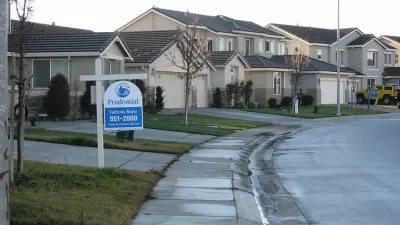Over one half of Detroit's foreclosed homes are blighted or abandoned. Buyers who purchased the homes for as little as $1 have little incentive to keep them in good shape—or pay taxes.

While Detroit has enjoyed sporadic rejuvenation, it continues to lose housing stock. Risky past lending is a key culprit. "The toll is massive: 56 percent of mortgage foreclosures are now blighted or abandoned. Of those 36,400 homes, at least 13,000 are slated for demolition at a projected cost of $195 million, The News found. The city lost another $300 million in tax payments from foreclosed homes that Wayne County seized for nonpayment of taxes."
Pre-2008, "Detroit had one of the highest rates of subprime lending in the country: 68 percent of all city mortgages in 2005, compared to 27 percent statewide and 24 percent nationwide, according to federal records."
While blight is also a function of faltering city services, the immense devaluation of foreclosed properties makes it easier for them to fall into a decrepit state. "Few efforts were made to hold institutions accountable for damage after those lenders blanketed city residents with risky loans, and then sold homes for as little as $1 after they were foreclosed on."
The lending industry claims no responsibility for what buyers do with their one-dollar homes. Quicken Loans founder Dan Gilbert, who co-chairs the Detroit Blight Removal Task Force, concurred. "[Gilbert] blamed high taxes and other factors. 'Existing blight causes other blight. Poor city services. All of it together.'"
It should be noted that, "All told, 52 percent of Quicken mortgages that ended in foreclosure from 2005-2014 are now blighted."
The article includes interesting slider visuals comparing blighted houses with their former inhabited selves.
FULL STORY: Foreclosures fuel Detroit blight, cost city $500 million

Alabama: Trump Terminates Settlements for Black Communities Harmed By Raw Sewage
Trump deemed the landmark civil rights agreement “illegal DEI and environmental justice policy.”

Study: Maui’s Plan to Convert Vacation Rentals to Long-Term Housing Could Cause Nearly $1 Billion Economic Loss
The plan would reduce visitor accommodation by 25% resulting in 1,900 jobs lost.

Why Should We Subsidize Public Transportation?
Many public transit agencies face financial stress due to rising costs, declining fare revenue, and declining subsidies. Transit advocates must provide a strong business case for increasing public transit funding.

Paris Bike Boom Leads to Steep Drop in Air Pollution
The French city’s air quality has improved dramatically in the past 20 years, coinciding with a growth in cycling.

Why Housing Costs More to Build in California Than in Texas
Hard costs like labor and materials combined with ‘soft’ costs such as permitting make building in the San Francisco Bay Area almost three times as costly as in Texas cities.

San Diego County Sees a Rise in Urban Coyotes
San Diego County experiences a rise in urban coyotes, as sightings become prevalent throughout its urban neighbourhoods and surrounding areas.
Urban Design for Planners 1: Software Tools
This six-course series explores essential urban design concepts using open source software and equips planners with the tools they need to participate fully in the urban design process.
Planning for Universal Design
Learn the tools for implementing Universal Design in planning regulations.
Smith Gee Studio
Alamo Area Metropolitan Planning Organization
City of Santa Clarita
Institute for Housing and Urban Development Studies (IHS)
City of Grandview
Harvard GSD Executive Education
Toledo-Lucas County Plan Commissions
Salt Lake City
NYU Wagner Graduate School of Public Service



























